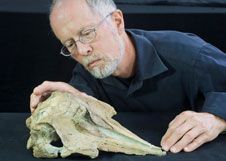Ancient Dolphin Fossil Found In New Zealand, ‘Papahu Taitapu’ Used ‘High Frequency Sound’ To Navigate [PHOTO]

A dolphin species has been discovered that lived 19 million to 22 million years ago.
Researchers from New Zealand’s University of Otago uncovered fossils of a skull, jaw, and a few other parts of an ancient dolphin in marine sedimentary rocks in the Cape Farewell region of the country’s South Island. Named Papahu taitapu -- after ''Papahu,'' the Maori name for dolphin -- the species is believed to be 6.5 feet long, roughly the size of the modern dolphin.
“Our study of structures of the skull and earbone suggest that Papahu could make and use high-frequency sound to navigate and detect prey in murky water,” researcher Gabriel Aguirre told the Australian. “They probably also used sound to communicate with each other.”
The findings, published in the Journal of Vertebrate Paleontology, describes how the ancient species had similar teeth to modern dolphins, a wider head and lived in the shallow seas around proto-New Zealand.
"When we compared Papahu with both modern and fossil dolphins, we found that it belongs in a diverse and structurally variable group of ancient dolphins that evolved and spread worldwide 19–35 million years ago. All of those ancient dolphins, including Papahu and others, such as shark-toothed dolphins, are now extinct," professor Ewan Fordyce said in a statement. "They have been replaced by the 'modern' dolphins and toothed whales, which diversified within the last 19 million years.”
The discovery belongs to one of few dolphin fossils found from that period, making the find even more significant, researchers say.
New Zealand is home to many cetacean fossil discoveries – especially those belonging to the Oligocene period of 24 million to 34 million years ago. Scientists say a combination of a cooling climate during this period combined with the opening of the Southern Ocean led to mass quantities of krill and other small crustaceans – the favored prey of baleen whales.
Fordyce says the findings could shed light on how ancient dolphins evolved.
"When we look at it we think, gosh, it's a dolphin, ok, and it's a bit like modern forms, but when we look closely, it differs in quite a few fine details,” Fordyce told Radio New Zealand. “The structures in this little Papahu dolphin help us understand the transition from the very early archaic extinct dolphins into some of the more modern forms."
© Copyright IBTimes 2025. All rights reserved.






















